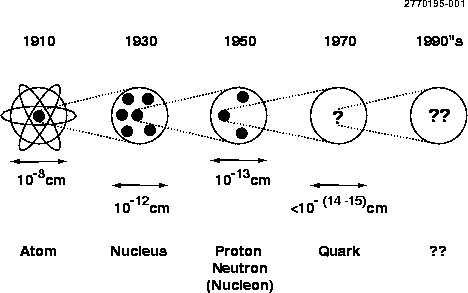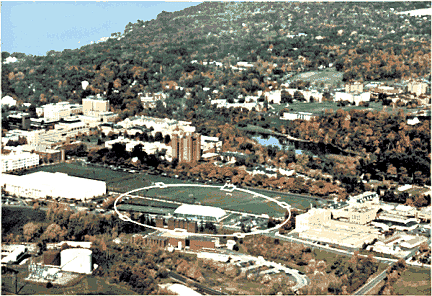
The progression of structure within structure from the atoms that make up the familiar matter we see around us to the quarks that are thought to be the basic building blocks of nature.
To date, quarks and electrons seem to be indivisible. There is no evidence that they have finite size or structure, and they cannot be broken into smaller more fundamental objects. We think they are the fundamental building blocks of matter. Everything we see around us in everyday life is made from two different types of quarks (called up (u) and down (d)), electrons (e) and neutrinos([[nu]]e), where the neutrino has to be thrown in to explain the radioactive decay of some nuclei.
Unfortunately, the list of building blocks does not stop here. The u and d quark, the electron, and its neutrino form what we call the first generation, and while all the matter we see around us can be formed from these first generation building blocks, two other heavier generations of quarks and electron-like objects (called leptons) are needed to explain the variety of particles that have been observed in cosmic rays and high energy particle accelerators.
Generation I II III
Quarks up (u) charm (c) top (t)
down (d) strange (s) bottom (b)
Leptons electron (e) muon (u) tau
electron neutrino muon neutrino tau neutrino
The fundamental constituents from which all matter is made. All the
matter that has been observed is made from the particles listed in
this table and their anti-particles.
Force Carrier of Force Gravity graviton Strong gluon (g) Electromagnetic photon Weak Z, W+, W-The fundamental forces of nature and the particles that transmit those forces.

An overview of the Cornell campus with the location of the CESR tunnel shown. The Wilson Synchrotron lab, which houses the CLEO detector, is in the lower part of the picture.
Using an electron-positron storage ring to study quarks is a bit like trying to figure out how a watch works by smashing two watches together and studying the pattern of broken pieces that emerge. We never get to see the b quarks we produce, because they live only a very short time, but we see the fragments from their decay in a large detector called CLEO. A collaboration of 200 physicists from Universities all over the country participate in the collection and analysis of data from CLEO. In terms of budget and size, the CESR/CLEO facility is relatively modest, but in terms of physics productivity, we are rivaled only by the giant European high energy physics laboratory, CERN and the Fermi National Accelerator Lab out side of Chicago. Yet, for all its preeminence as a world class high energy facility, CESR is very much a campus based lab with faculty, graduate students and even undergraduates playing major roles in making it work. The hands on, shirt-sleeves rolled up spirit of everyone pitching in to get things working has proved enormously successful over the years and the 'Cornell style' is famous throughout the field.
How is data from CESR contributing to our understanding of nature at its most fundamental level? With our machine, we can study all of the particles listed in Table I except for the t quark which is too heavy for us to be able to produce it. The focus of our program, however, has been primarily on studies of the b quark, and that is because we hope that the b quark will offer a clue to a very deep mystery--why we are here.
In the very early universe, a few instants after the 'Big Bang,' we think that there were equal amounts of matter and antimatter. Now, more than ten billion years later, the antimatter has gone away. Our solar system is made entirely of matter, and for as far out into the universe as astronomers can probe (about 60 million light years) we can find no evidence for significant amounts of antimatter. Where did it all go? It has been suggested that the matter that we see now is the result of a very tiny excess of matter over antimatter that formed in the very early universe due to a property of the weak interaction called CP violation. The violation of CP means that in a physical process such as the decay of a particle, if one changes particle to antiparticle everywhere and reverses left and right, then the rate for this new process will be different. The result is that matter and antimatter decay slightly differently, which could account for the excess of matter over antimatter that we see around us today. If there had been no CP violation, matter and antimatter would have annihilated in the hot early universe and nothing would have been left to become us and the galaxies that surround us. Clearly this phenomenon of CP violation is very important, and the b quark provides a crucial input to our understanding, because b quarks are predicted to exhibit small but measurable CP violation in their decays. With a data sample of about 30 million b quarks, we might hope to observe it.
At Cornell, we currently have the worlds largest sample of b quark data, but we need 10 times more data than we presently have before we can attack this problem. A great deal of our effort is going into improving the storage ring so that it will produce a pair of b quarks every second or two instead of the current rate of once every 10 seconds. We are also working on improving our detector to make it more efficient at recording b quark events. If we can succeed at finding experimental evidence for CP violation in b quark decays, we will be a big step closer to understanding the origins of the universe. The search will not be finished because we will still be a long way from being able to prove that CP violation in the early universe and CP violation (if observed as predicted) in b quark decays are related. There are many other questions we need to answer as well. Why are there 3 generations of particles and not more or less? Why do the particles listed in Table I have the masses they do? Why is CP violated in the weak interactions but not, as far as we know, in the strong or electromagnetic interactions? Are the particles listed in Table I really the fundamental building blocks of nature, or do they themselves have a structure? My own personal guess is that as we do increasingly precise experiments with our ever expanding data sets, we will find that the simple picture of nature outlined in Tables I and II is inadequate to explain the data and that nature has some big surprises in store for us.
Persis Drell, persis@lns62.lns.cornell.edu